What makes a great chart-topping song? Is it the danceable beat? The catchy melody? Or is it the words that move you? When it comes to lyrics, it’s hard to avoid noticing the two common themes in pop music: love and sex. These universal aspects of human experience are relatable to nearly everyone, and songwriters know that's a surefire recipe for a hit.
To better understand the evolution of love and sex in popular music, we counted up the occurrences of “love” and “sex”, including occurrences in words like “beloved” and “sexual”, in every song on the Billboard Hot 100 charts from 1960 to 2014. These hit songs represent the most popular music that can be both reflective of, and influential on social attitudes over time. The U.S. Billboard Hot 100 strongly reflects global trends in music: of the world’s 10 most successful solo acts, 8 are from America. Follow up research currently in the works will similarly look at the U.K. singles chart over a similar time period and explore differences with that which is found here.
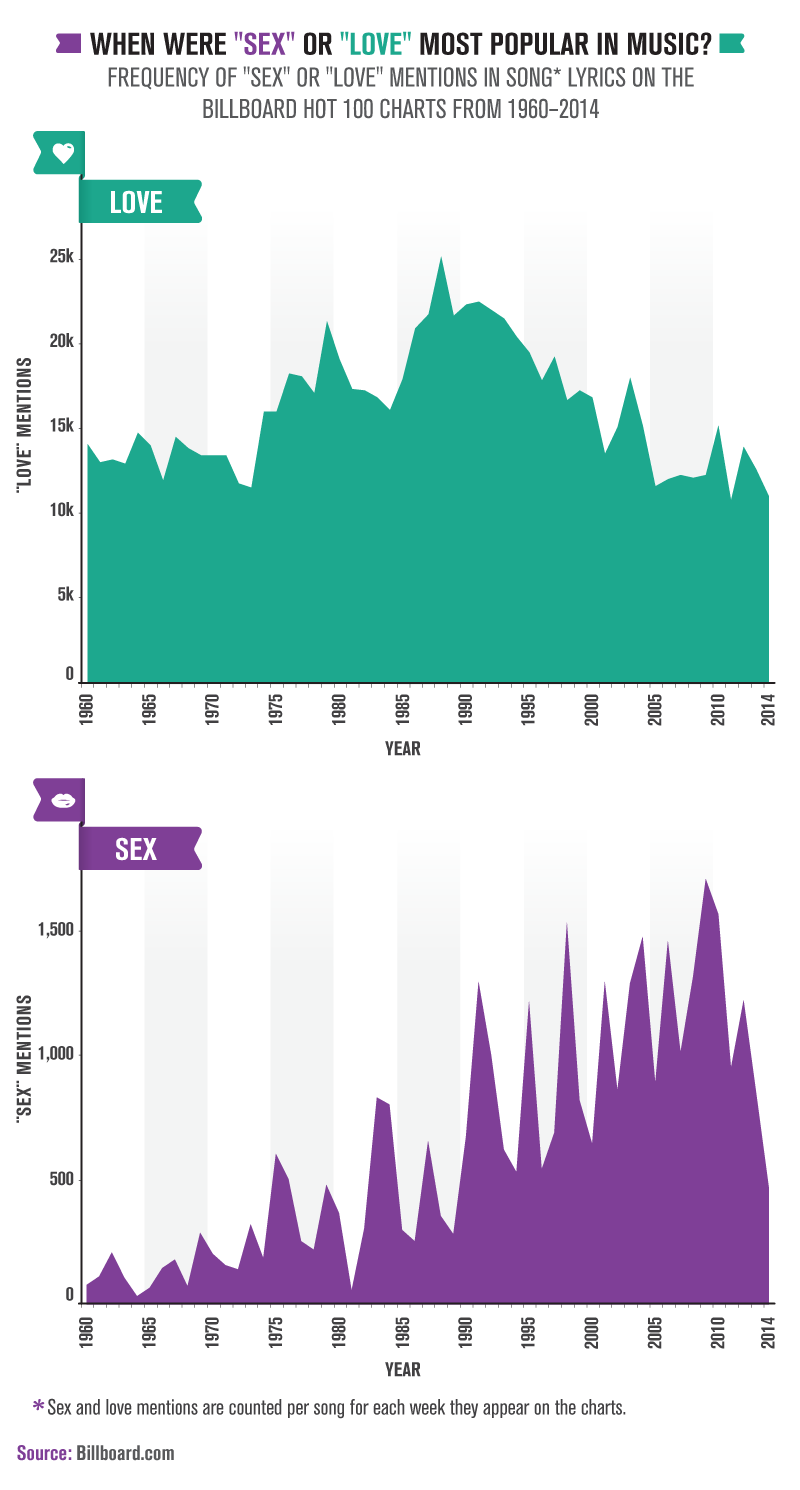
When we look at the mentions of "sex", "love", and related terms in the lyrics of songs appearing in the Hot 100 since 1960, it’s easy to see how popular the two have been over time. One of the most striking trends is that while love has waxed and waned, sex has skyrocketed, with mentions becoming several times more common in the 2010s than in the 1960s. We counted how many times each word is mentioned in a song - for instance, if a song mentions sex four times, and it’s on the charts for 10 weeks, it’s counted 40 times.
But even as mentions of “sex” in music have increased over time, the number of “love” mentions is still far greater overall. “Sex” mentions peak at a little over 1,500, while “love” mentions peak at approximately 25,000.
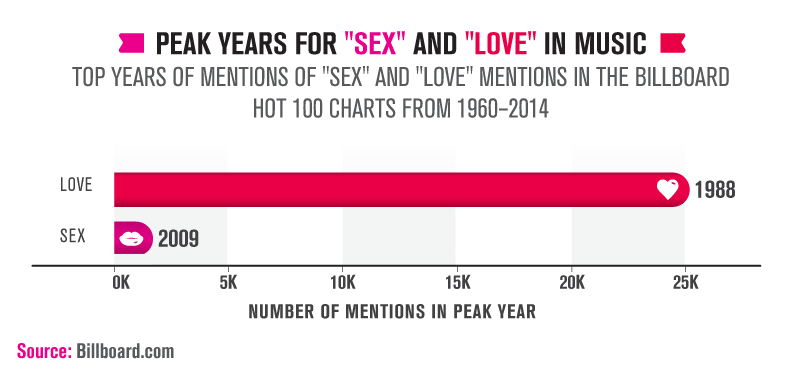
When it comes to “love,” mentions have peaked many times since the ’60s but most noticeably in the late ’80s and early ’90s. The emergence of ballad queens such as Mariah Carey and Whitney Houston could explain these spikes in mentions, as well as the power ballads of metal and rock bands like Poison and Whitesnake.
Mentioning “sex” in titles and lyrics of chart-topping music was an uncommon occurrence until the late 1980s, which saw the continuing emergence of MTV as a cultural force among youth. The ideas of sticking it to the man, drugs, and partying could have contributed to the spike in “sex” references around this time. This may also reflect the continuing growth of sexualised content across all media – for instance, occurrences of sexual content on television almost doubled between 1997 and 2001.
“Sex” mentions reached their peak in 2009: “Love Sex Magic” by Ciara and “Birthday Sex” by Jeremih both made it to the top 10 of the Billboard Hot 100. These are just two examples of artists that contributed to the spike in “sex” mentions. Interestingly, “sex” mentions appear to follow a consistent up and down cycle, peaking for a year or two before falling dramatically, with this pattern repeating throughout the decades.
Considering the culture around these spikes of “sex” mentions is also important. In 1991, 54.1 percent of American high schoolers had reported having intercourse; at the turn of the century, rates began to drop – and in 2013, the percentage of high school youths reporting they’d had intercourse dropped to 46.8.
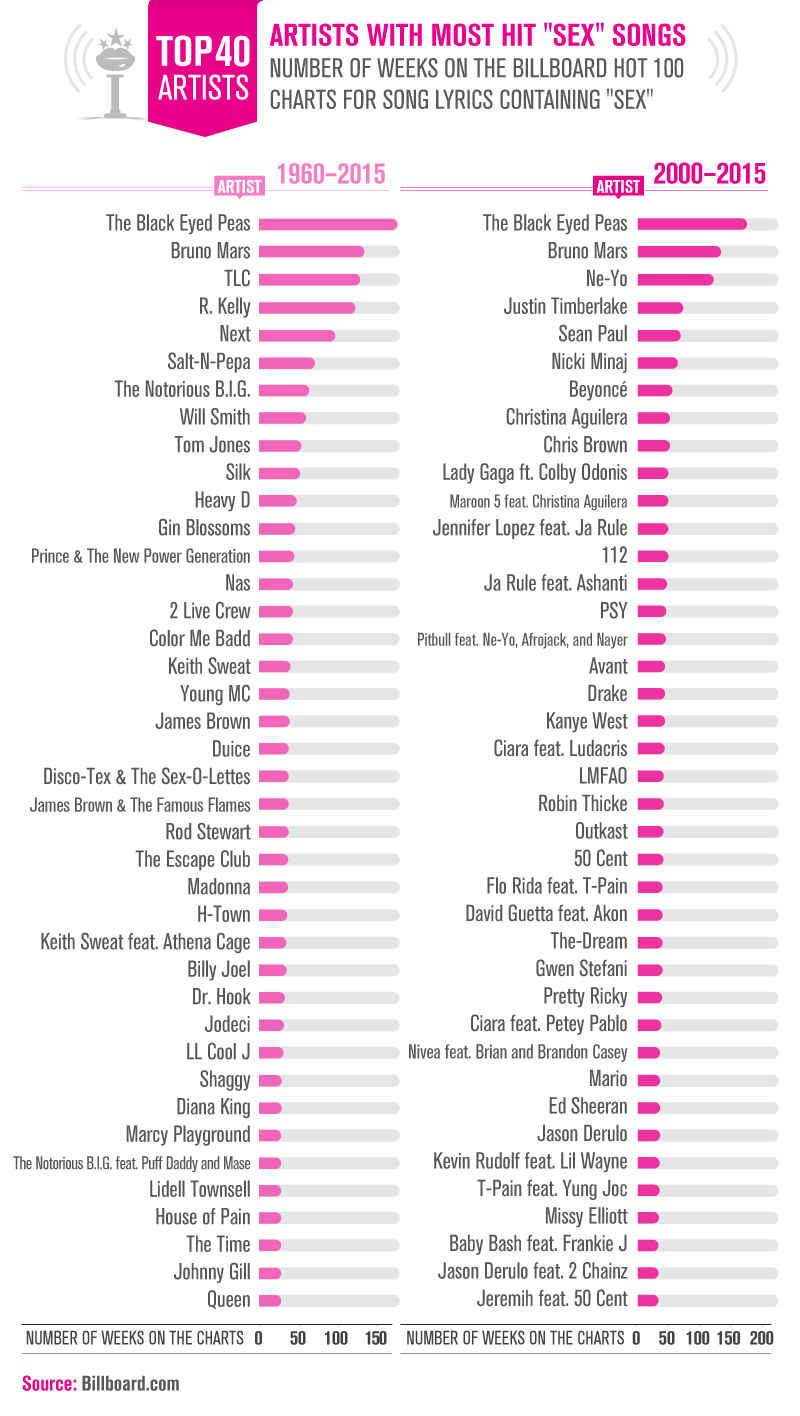
Sex was a leading topic for these groups of 40 artists, who spent time on the charts by talking explicitly about getting down. In the 1970s and 1980s, Marvin Gaye in particular became known for a sexual, sensual brand of soul music, and in the 1990s, modern R&B continued this trend.
We can see this pattern play out near the top of the charts with 1990s R&B artists like TLC, R. Kelly, and Next, each of whom had multiple hits that remained on the Billboard charts for weeks. Meanwhile, hip-hop artists popular in the early ’90s, such as Notorious B.I.G. and Salt-N-Pepa, were pushing lyrical boundaries – their chart-toppers rarely shied away from openly talking about sex.
And when we look at results limited to the past 15 years, there’s a steady increase in songs containing lyrics about sex, and while the roster of artists changes, the styles remain constant. The top 10 artists in the last 15 years read like a who’s-who of R&B and hip-hop hitmakers: The Black Eyed Peas, Beyoncé, Ne-Yo, Chris Brown, Bruno Mars, and Justin Timberlake all make an appearance.
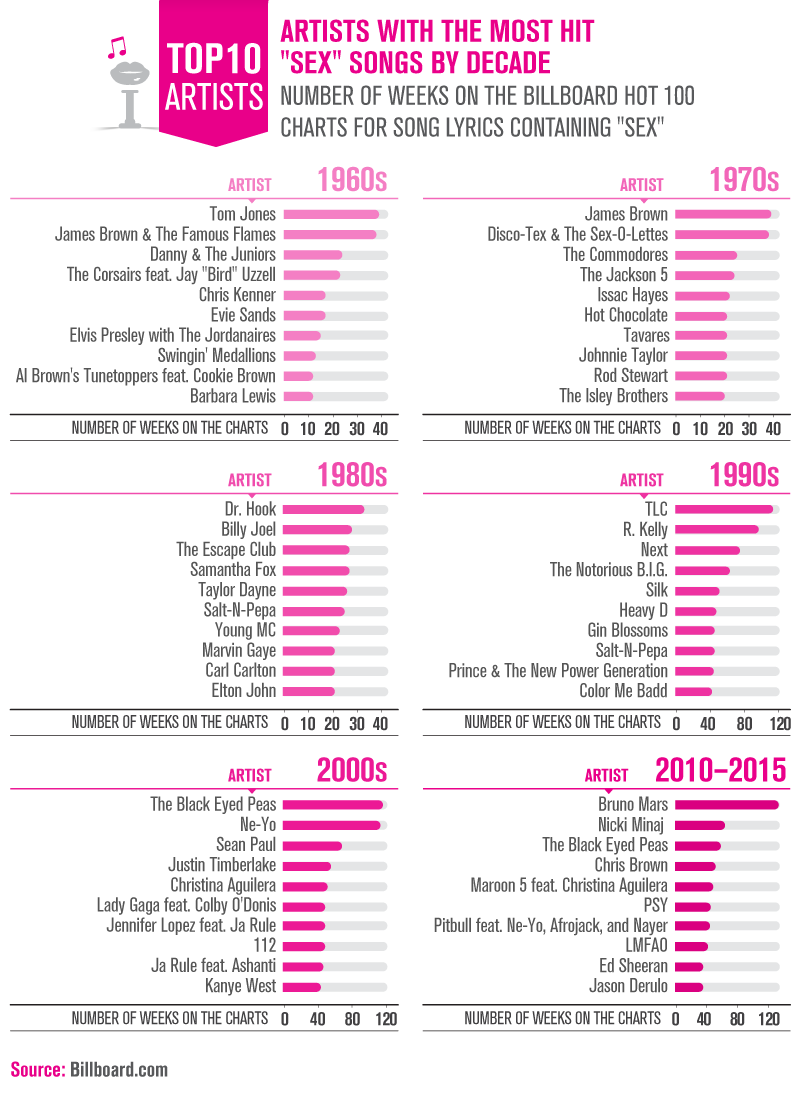
When we break down mentions of “sex” by Billboard chart-topping artists by decade, we get some interesting results. While Tom Jones spent the most overall time on the charts with songs containing the word “sex,” it was the trailblazing James Brown who had the greater number of songs with “sex” in the lyrics. Brown's streak of hits containing the word “sex” continued into the ’70s, as he led that decade in weeks spent on the charts for songs with “sex” mentions.
And while the ‘60s are often thought of as a time when sex was taboo in pop music, this analysis shows that top artists’ songs in that period that overtly mention “sex” actually outperformed the songs of top artists mentioning “sex” in the ’80s. Why? It’s an explanation that’s more cultural than scientific, but the 1980s were a time of a conservative revival in the U.S. as well as in the U.K. This decade was one of Reagan, Thatcher, the War on Drugs, and the Moral Majority. It was also the era of the Jello Biafra obscenity trial, the birth of the Parents Music Resource Center, and origin of the “Parental Advisory” sticker. All of these social factors may have formed a perfect storm to remove “sex” from the charts.
However, in the ’90s, artists struck back. Gangsta rap emerged in the late ’80s and early ’90s alongside a sex, drugs, and rock ’n’ roll attitude, and we can see an explosion in the amount of time sex-mentioning top artists spend on the charts. The top artist of the 2000s, The Black Eyed Peas, spent quadruple the weeks on the charts with “sex” songs as Dr. Hook did in the 1980s. That trend continues to this day, and Bruno Mars has now spent 140 weeks on the charts since 2010 – and the decade is only half over.
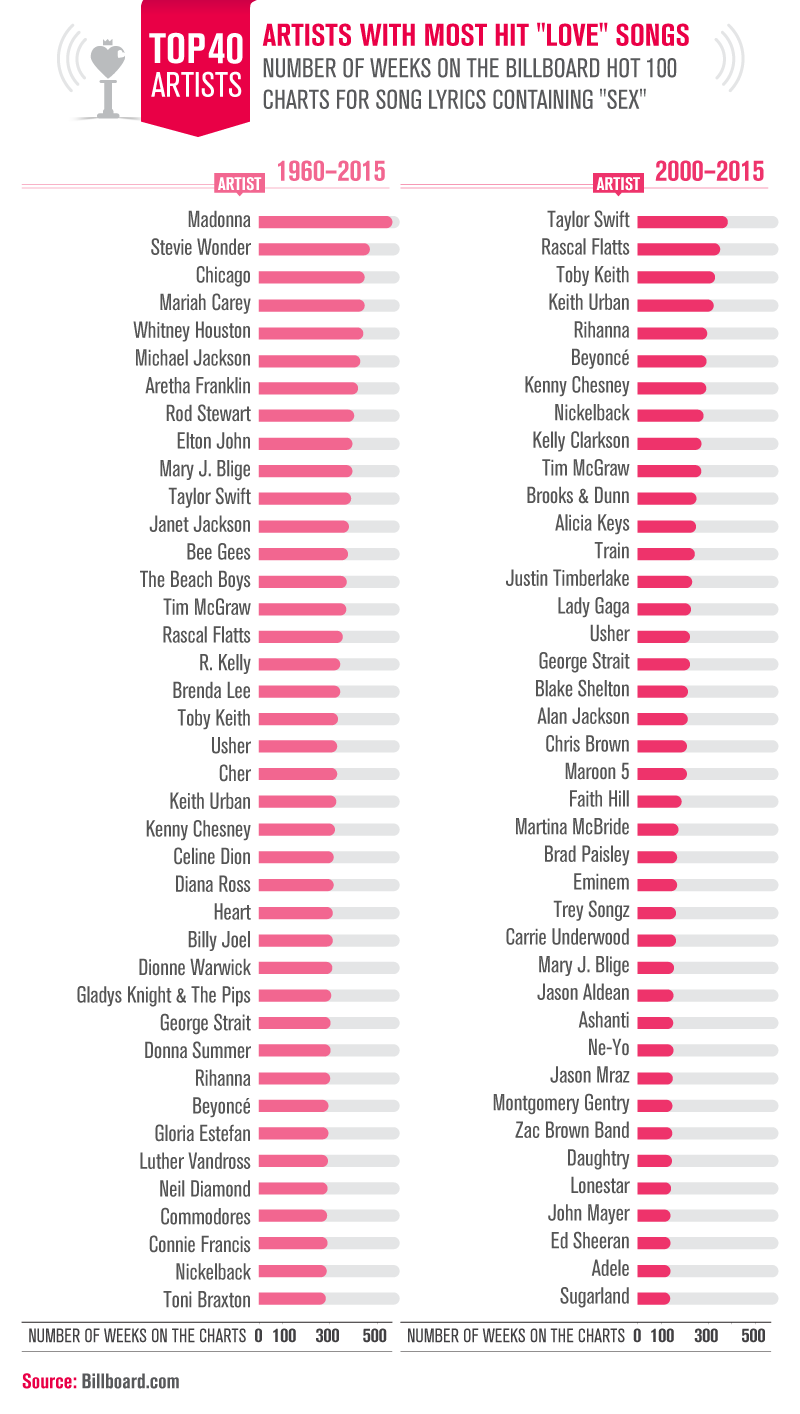
“Love” as subject matter in music predates pop culture by millennia. In fact, love in music dates as far back as the 8th century BC, with Homer’s epic poems, the Iliad and Odyssey, set to musical accompaniment. As popular music continued to evolve, love didn’t go anywhere, and it still serves as a dominant theme in many chart-topping hits.
Above are lists of top 40 artists with chart-topping hits mentioning “love.” Madonna, Chicago, Stevie Wonder, Aretha Franklin, Rod Stewart, Whitney Houston, and Elton John are the top seven artists for all years studied, a testament to their staying power in the pop limelight. Interestingly, Madonna takes first in this category, despite playing a key role in the sexualisation of pop music. Although the contexts of her songs are clearly evident, she uses less overt terms to communicate this.
But in the past 15 years, a new trend has emerged: Country artists are scoring hits with love. Is it that pop music is increasingly moving away from romance and toward sex, while country music has retained more modest values? The continuing overall popularity of “love” compared to “sex” would suggest otherwise. But at the turn of the millennium, the popularity of country music was on the rise, with artists such as Shania Twain, Rascal Flatts, and the breakout Taylor Swift. In addition, country music is the No. 1 radio format across the United States, which helps the genre’s artists rocket to the top of the charts.
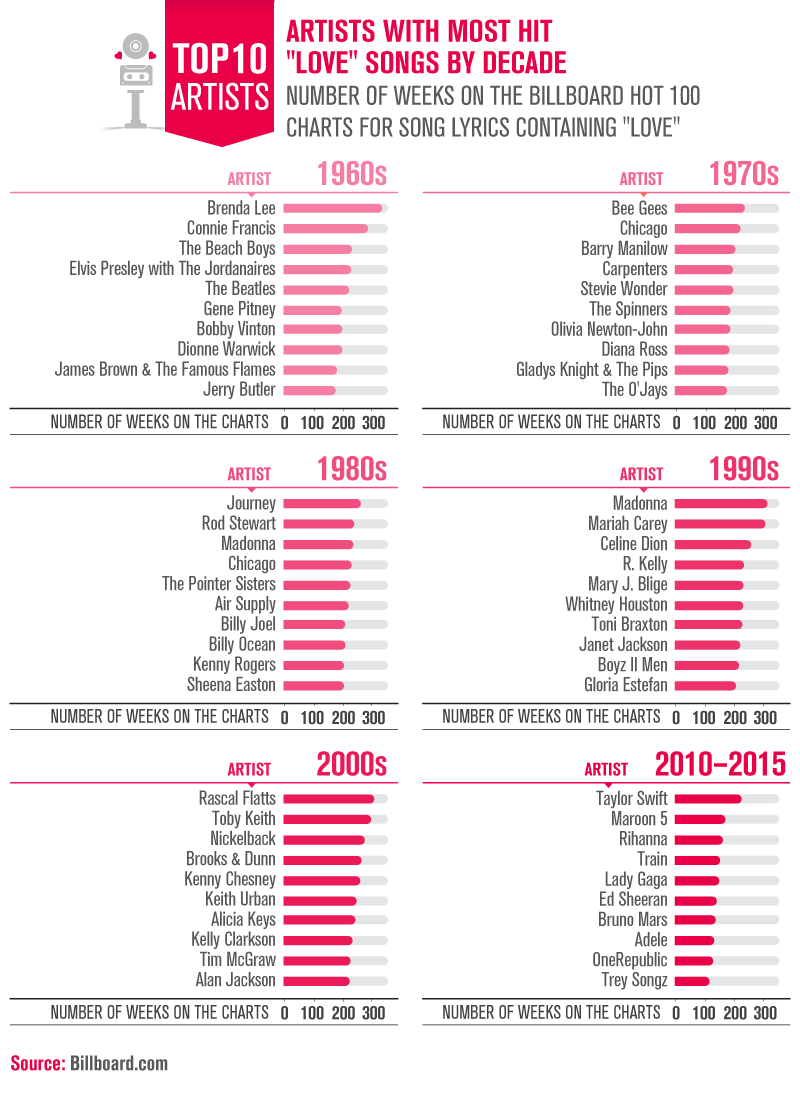
While we might think the topic of love in the 1960s would be dominated by The Beatles, famous for hits such as “Love Me Do” and “Can't Buy Me Love,” it was two women who had the most weeks on the Billboard charts in the 1960s with songs about love. Country artist Brenda Lee topped the charts with hits like “I'm Learning About Love” and “When You Loved Me,” while pop-rocker Connie Francis hit it big with “Don’t Break the Heart That Loves You” and “Looking For Love.”
As the years roll on, the changing face of pop music becomes apparent: In the 1970s, hitmakers like the Bee Gees, Chicago, and Barry Manilow topped charts with their songs of love. And while we've talked about chart-toppers for “love” and how these lists typically include iconic artists, the 1980s have one notorious exception – Michael Jackson, the “King of Pop” himself. In the ’80s, Jackson was only 35th on our list of “love” mentions, rising to the 15th spot in the ’90s.
Instead, it was Journey, Rod Stewart, and Madonna who were the leaders of “love” in the ’80s. Chicago would continue its string of chart success into the 1980s as well, while Madonna carried her reign into the 1990s, churning out a series of “love” hits along with Mariah Carey and Celine Dion.
Interestingly, in the 1990s, one of the top artists talking about sex shows up as a top artist for love mentions as well: R. Kelly. But while the word “love” may be common in his lyrics, the context behind it may be more sexual. R&B artists have often taken to more “romantic” ways of referring to sex, using phrases like “making love” and “I want to love you.”
In the 2000s, country artists continued crooning over love and taking over the charts: Rascal Flatts, Toby Keith, Brooks & Dunn, and Kenny Chesney were four of the top five artists. And between 2010 and 2015, Taylor Swift was at the top for more than 227 weeks. Swift has spent almost as much time on the charts in five years with songs about love as Journey (237 weeks) did in an entire decade.
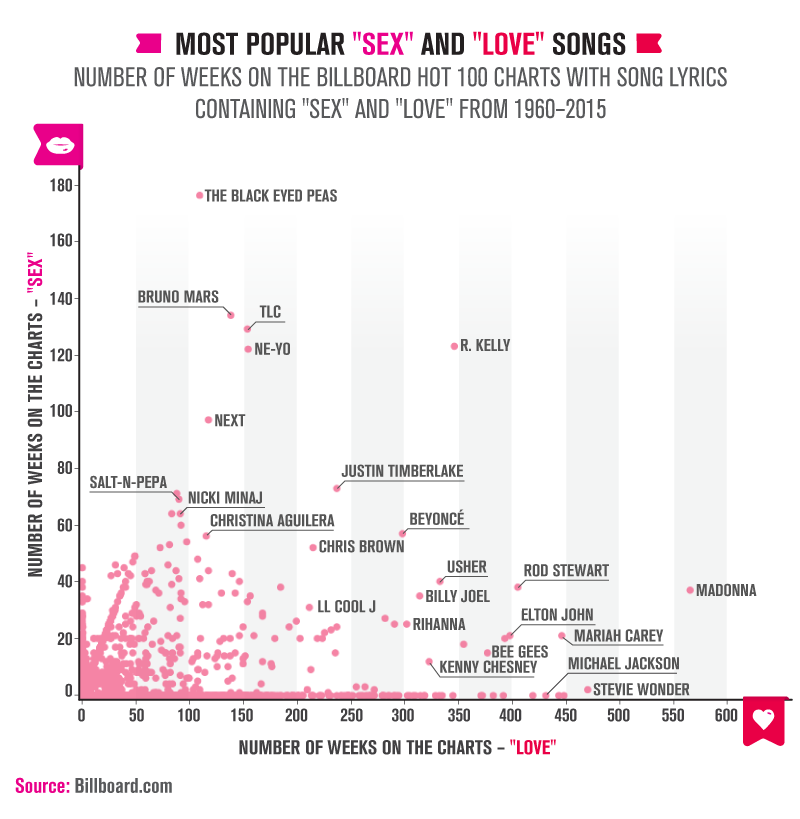
Now, let’s look at Billboard’s chart-busting artists and whether they lean toward talking about love or sex. Many artists who spent time on the charts with songs referring to love hardly mentioned sex at all – and the opposite is true for artists who predominantly mentioned sex.
Artists who mostly mentioned sex in their music didn’t spend many weeks on the charts. Those who largely mentioned sex but did not mention love maxed at about 50 weeks. However, artists mentioning sex made much longer appearances on the charts if they also mentioned love.
Conversely, many artists did well on the charts with many mentions of love but few or no mentions of sex. Stevie Wonder, for example, had great success with almost no explicit references to sex in his music.
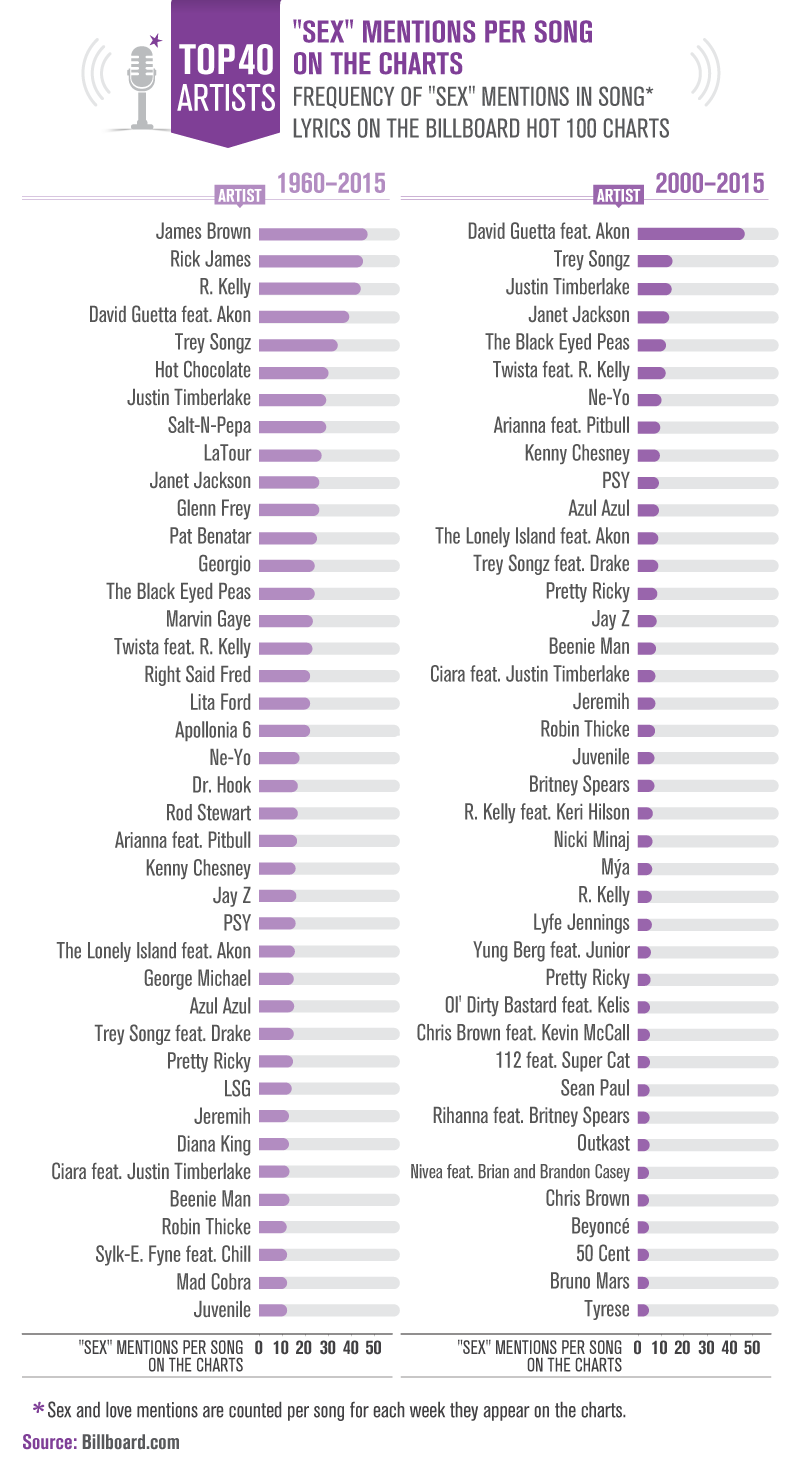
By an absolute measure, the term “sex” itself and its derivatives are not mentioned nearly as often as “love” in songs appearing on the Hot 100 charts. Consider this: The leader, James Brown, tops the list with over 40 occurrences of “sex” in songs on the Hot 100. The leader for love, revealed in the next graphic, reigns with close to 500 mentions.
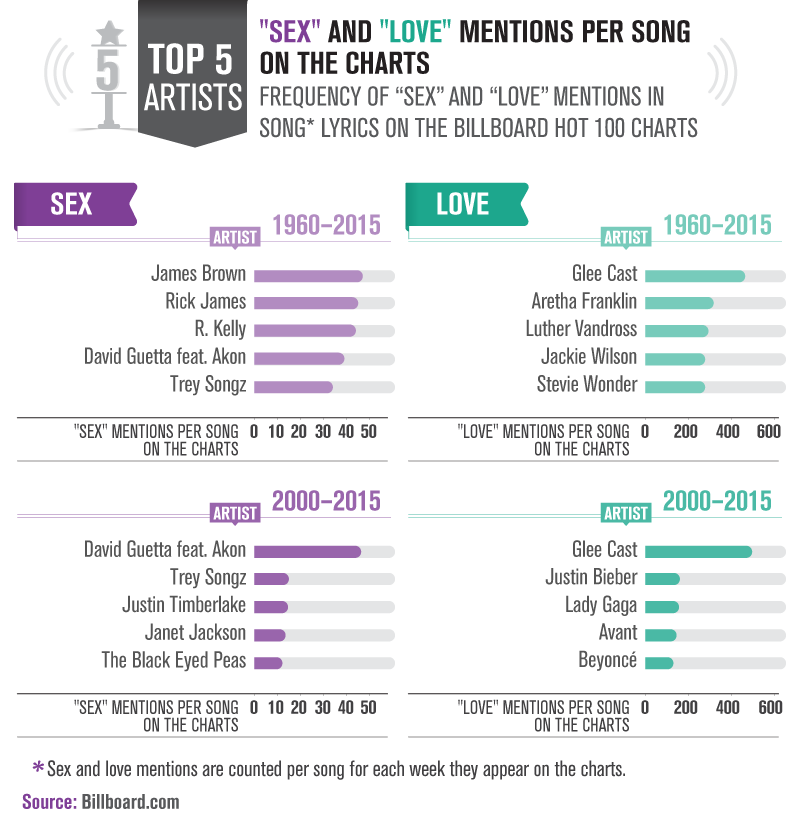
Overall, it’s soul, R&B, and hip-hop artists who are ahead of the list in terms of overall “sex” mentions since 1960. The same trend applies for the past 15 years: Mentions of “sex” are still dwarfed by those of “love.” However, as mentioned, artists often find ways to reference sex using coy terms such as “getting it on” and “lovin’ you” or by using even more explicit words. These charts refer only to artists who explicitly say “sex.”
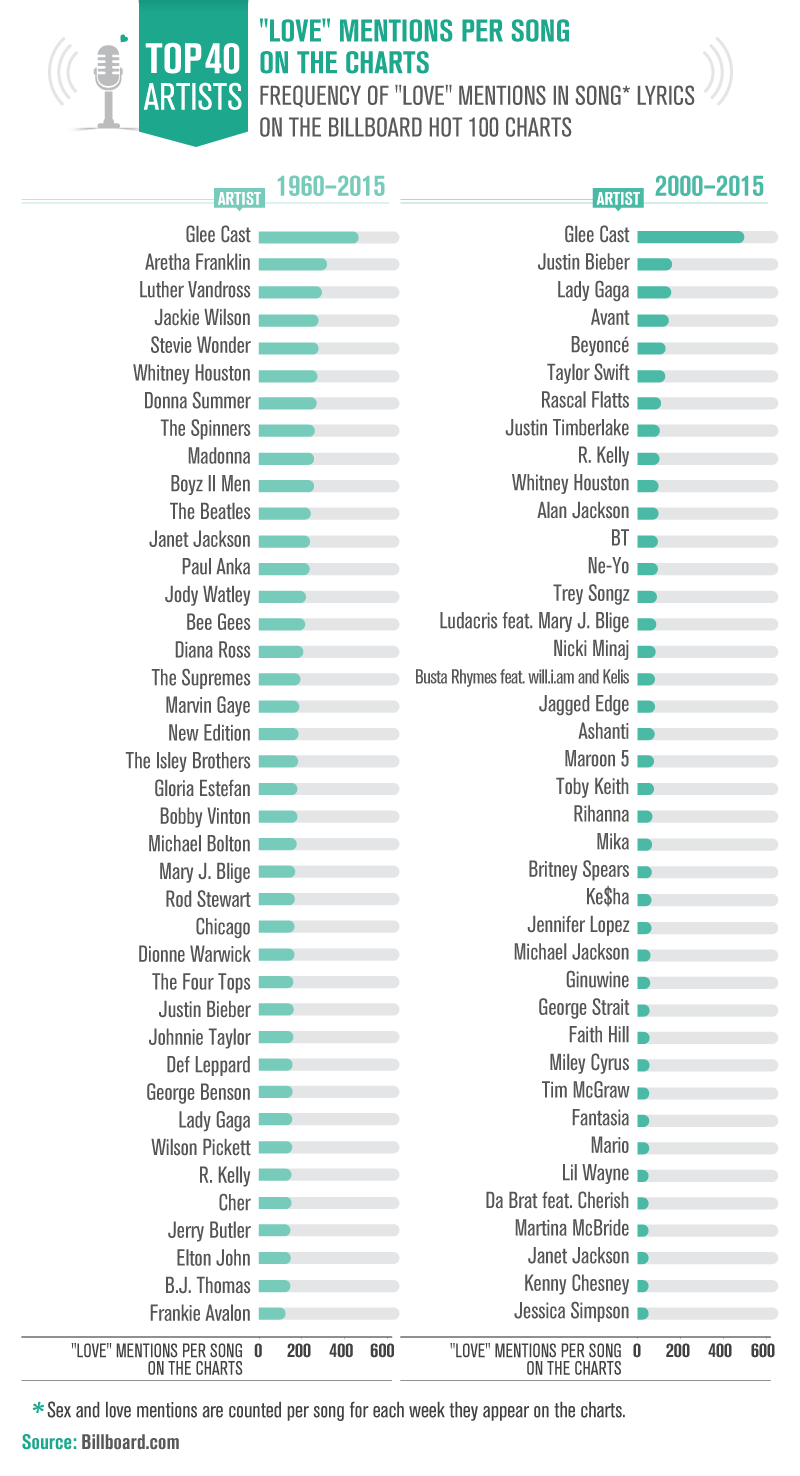
When you look at the artist's most frequently talking about love scoring Billboard hits, one all-time leader emerges that blows away the competition: the cast of the hit series Glee.
Why does Glee dominate? First, it’s important to note the group actually has the most Hot 100 appearances of any artist in history. Remarkably, they accomplished this without heavy radio play, relying instead on their TV audience to boost popularity. Glee was pulling in 11.6 million viewers each week at the height of the show’s popularity. The series focused on a high school choral group performing cover versions of different chart-toppers each week – meaning they cumulatively have as many mentions of “love” as all the top artists they’ve covered.
Looking beyond Glee, many of the artists with the most all-time mentions of love are soul and R&B legends with long careers, such as Aretha Franklin, Stevie Wonder, and Luther Vandross. Over the last 15 years, the kings and queens of “love” include pop-geared artists such Lady Gaga and Justin Bieber. However, R&B is still present on the modern list of “love,” with Beyoncé, Justin Timberlake, and R. Kelly topping the list from the past decade.
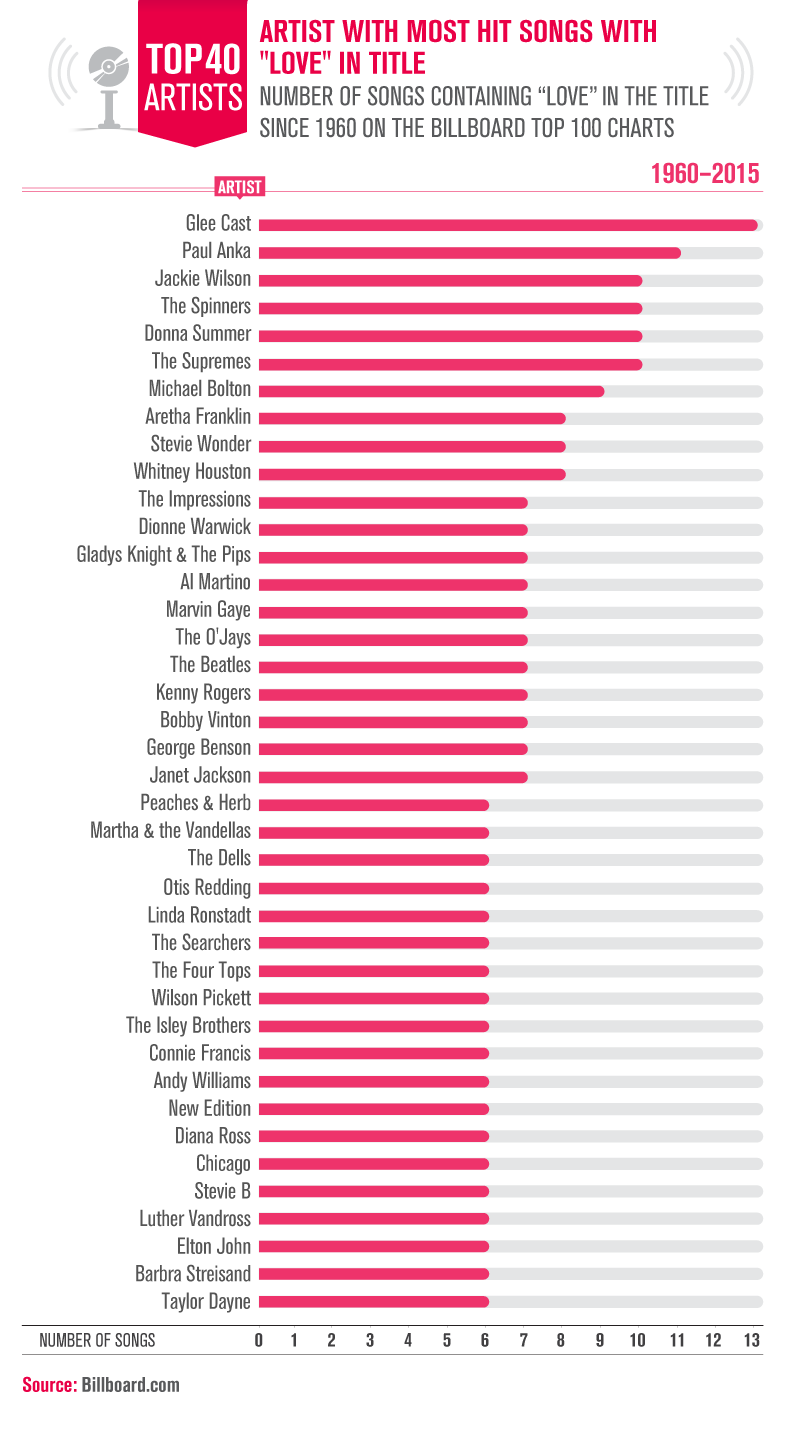
We also explored the number of artists over time who aren’t just singing about love but putting it at the forefront of their works by including the word in their song titles.
Looking at the list, one thing becomes clear: “Love” as a song title is a game for the old-fashioned. Not one chart-topping artist who features the word in a song title – aside from the Glee cast, which could be excluded for not producing original songs – has a recording career that started after the 1980s. Instead, the chart is dominated by singers like Paul Anka (“Goodnight, My Love”), Jackie Wilson (“This Love Is Real”), and The Supremes (“Stop! In the Name of Love”).
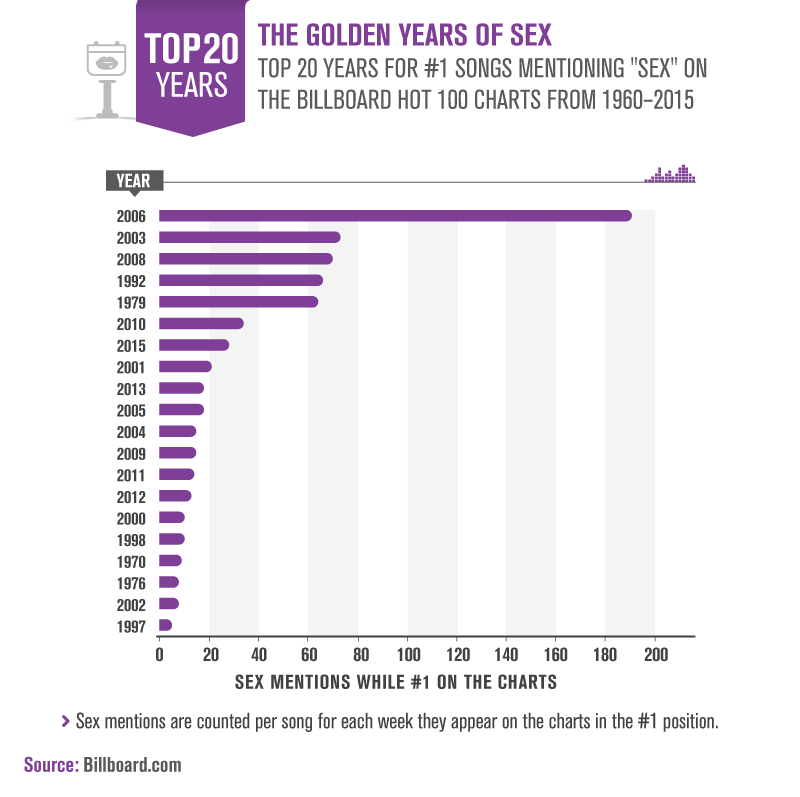
We looked at the number of times that sexual terms were mentioned in No. 1 songs each year, ranking the years which had the most actual mentions of sex. Unsurprisingly, the most frequent appearances of sexual content occurred more recently: eight of the 10 top years were 2001 or later. 2006 placed far ahead of the pack due to the success of “SexyBack” by Justin Timberlake, while 2003 featured the explicit hit “In Da Club” by 50 Cent. The exceptions to this recent trend, 1992 and 1979, were largely due to “I’m Too Sexy” by Right Said Fred and “Da Ya Think I’m Sexy?” by Rod Stewart, respectively.
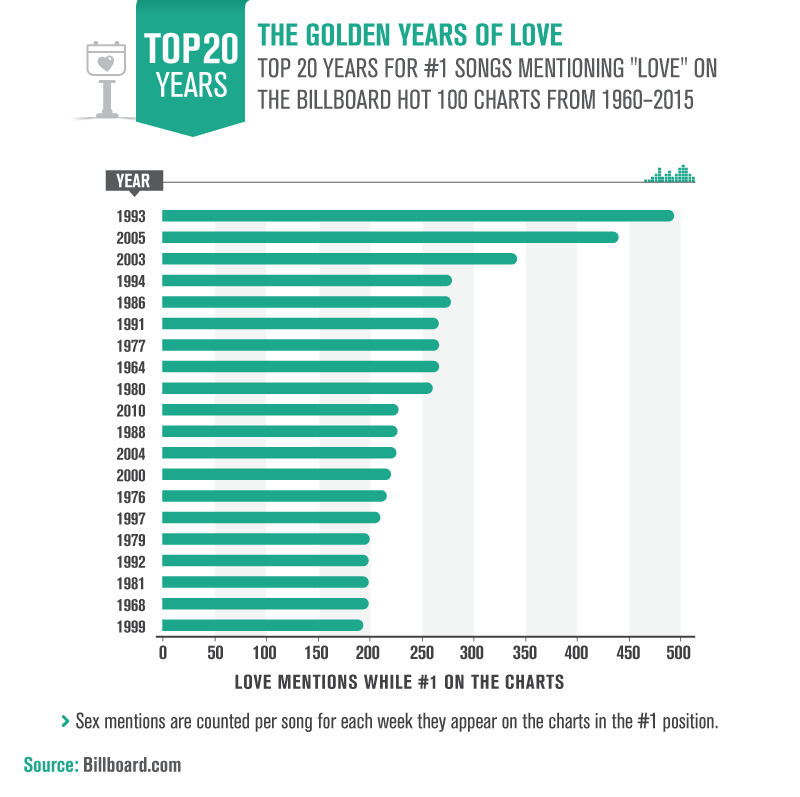
Love’s continued reign on the charts is evident from how many times “love” and related terms are mentioned in No. 1 hits – at peak, yearly “sex” mentions top out at nearly 200, while yearly “love” mentions approach 500. 1993 features hit singles such as “Dreamlover” by Mariah Carey, “Can’t Help Falling in Love” by UB40, and “I’d Do Anything for Love (But I Won’t Do That)” by Meat Loaf. 2005 was another big year for songs about love, with chart-toppers such as “We Belong Together” by Mariah Carey and “Let Me Love You” by Mario, and 2003 saw the debut of smash hits like “Crazy in Love” by Beyonce and “All I Have” by Jennifer Lopez. These hits and more are part of an ongoing pattern of love references being far more common than explicit sexual lyrics.
So Sex Sells, Right?
It’s true that references to sex have gained momentum in today’s pop music, and we see artists including the word in their lyrics at growing rates. With greater use of media via smartphones and MP3 players, and increasing depictions of overt sexuality in popular culture, the listeners of today are exposed to more explicit discussion of sex than ever.
However, “love” is here to stay. Even as mentions of sex are on the rise, the word “love” continues to show up all over the lyrics of today’s top pop artists, as it has since the dawn of popular music at the turn of the 20th century. As we look throughout music history, one conclusion is clear: In pop music, sex sells – but love sells even better.
Pop culture may send mixed messages about love and sexuality, but when you want reliable advice on personal and sexual health, it's best to turn to the experts. At Superdrug Online Doctor, you can find medical expertise and discreet advice from doctors on a variety of sexual health topics. Get the knowledge you need for your well-being and sex life, and visit Superdrug Online Doctor today.
Methodology
Superdrug Online Doctor commissioned us (Fractl) to scrape the Billboard Hot 100 charts from 1960–2015 for instances of “sex” and “love” in song lyrics. To arrive at our numbers, we counted the figures in two ways: First, we accounted for weeks spent on the charts for “sex” or “love” songs. So if a song mentions “sex” or “love,” and it stays on the charts for three weeks, it was counted in the data for those charts three times. When we refer to “mentions” of “sex” or “love,” that equals each time “sex” is said in a song; so if a song mentions “sex” or “love” 10 times and stays on the charts for three weeks, it’s counted 30 times.
Sources
- https://www.Billboard.com
- https://nccd.cdc.gov/Youthonline/App/Default.aspx
- https://www.nielsen.com/us/en/insights/report/2014/state-of-the-media-audio-today-2014/
- http://zap2it.com/2015/03/glee-series-finale-ratings-season-high-but-smaller-than-one-might-think/
- https://www.barnesandnoble.com/review/from-troubadours-to-twerking-ted-gioia-on-the-history-of-love-songs
- https://www.avclub.com/article/cheesecake-jelly-roll-lobsters-egg-yolks-and-stayi-203458
- https://www.billboard.com/music/rod-stewart/chart-history
- https://www.vanityfair.com/news/2000/11/mtv200011
- https://pediatrics.aappublications.org/content/126/3/576.full
- https://www.vanityfair.com/magazine/1992/10/madonna199210
- https://aspe.hhs.gov/basic-report/influence-new-media-adolescent-sexual-health-evidence-and-opportunities
- https://www.ncbi.nlm.nih.gov/pmc/articles/PMC3613286/
Fair Use
You are permitted to share the images and research found on this page, provided that you attribute the creators and link back to this page so your readers may learn more about the project and any related research.
